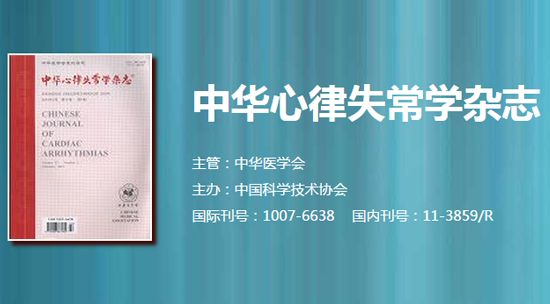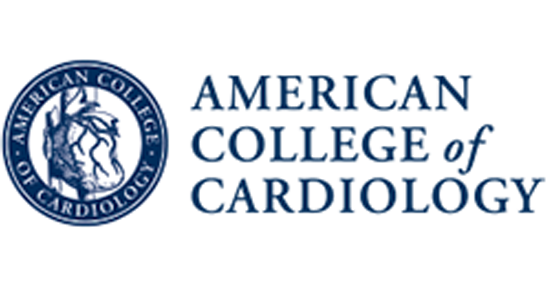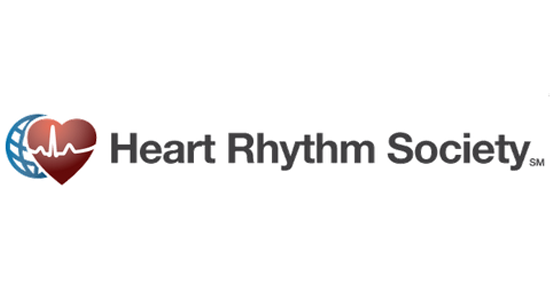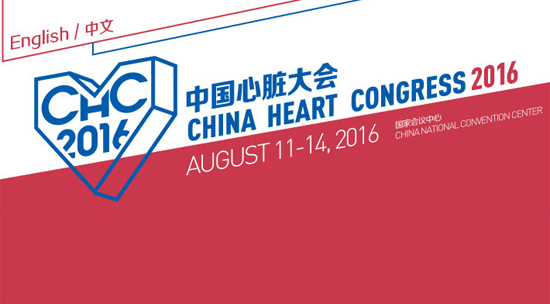HeartRhythm主编—陈鹏生教授语音速递(十一月刊 英文版)
<< First issue in Novenmber 2020 >>
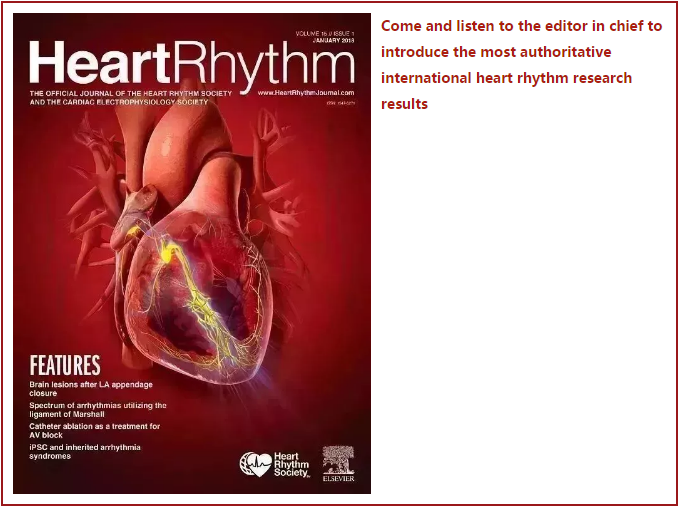

The first original article is titled “Catheter ablation of atrial fibrillation using Ablation Index guided High Power (50W) for pulmonary vein isolation: with or without esophageal temperature probe?” The authors studied 60 patients with and 60 patients without esophageal temperature probe. Two patients in the first and one patient in the second group had small esophageal lesions after ablation. The authors conclude that the incidence of ablation-related endoscopic esophageal-lesion was comparably low between patients with and without using the temperature-probe during ablation-index guided high-power ablation.
Coming up next is a paper titled “Cryoballoon Ablation of Pulmonary Veins for Persistent Atrial Fibrillation: Results From the Multicenter STOP Persistent AF Trial”. The STOP Persistent AF was a prospective, multicenter, single-arm, FDA-regulated trial designed to evaluate the safety and efficacy of PVI-only cryoballoon ablation for drug-refractory persistent AF. The authors found that cryoballoon ablation to be safe and effective in treating patients with drug-refractory persistent AF characterized by continuous AF episodes <6 months.
The next article is “Follow-up imaging after left atrial appendage closure”. There were a total of 530 patients in the study. Among them, TEE was done in 83.0% (440) and CT was done in 4.7% (25) at 4 months after procedure. Over a median follow-up of 12 months, 16 ischemic strokes, 8 transient ischemic attacks, and 1 systemic embolization occurred. Importantly, no ischemic strokes occurred between 45 days and 4 months. This study shows that delaying the first imaging post-Watchman implantation to 4 months was associated with no ischemic strokes between 45 days and 4 months. These data identify no compelling reason to perform TEE before the 4-month follow-up timepoint.
Up next is “Evidence of 2 conduction exits of the moderator band: Findings from activation and pace mapping study”. The authors performed mapping and ablation of moderator ban ventricular arrhythmias in 12 patients. The earliest activation site was free wall insertion in 8 patients (66.7%) and moderator band body in 4 patients (33.3%), preceding the QRS onset by 18 ms, and Purkinje-like potential was observed in 6 (50.0%). Pacing QRS complex from the moderator band was characterized by short QRS duration. The authors conclude that bidirectional conduction via the 2 exits during moderator band ventricular arrhythmias contributed to distinct ECG and electrophysiological characteristics, while pace mapping is of limited value in defining the ablation target.
The next article is “In-Hospital and Long-term Outcomes among Patients with Spontaneous Coronary Artery Dissection presenting with Ventricular Tachycardia/Fibrillation”. The authors analyzed the prospective Canadian Spontaneous coronary artery dissection registries for patients presenting with VT/VF during index hospitalization. Among 1056 consecutive patients, 84 (8.0%) presented with VT/VF. The authors found that these patients were at greater risk for in-hospital events and recurrent VF/VT at follow-up. Both VT/VF and LVEF <50% were independent predictors of subsequent VT/VF.
Coming up is “Clinical impact of left ventricular paced conduction disturbance in cardiac resynchronization therapy”. Among 137 patients who underwent CRT implantation, 81 patients (59%) responded to CRT. The difference between the time intervals from LV pace to RV sense minus from RV pace to LV sense was significantly longer in nonresponders than in responders. These findings show that LV paced conduction disturbance could predict nonresponse to CRT and poor outcome. Further intervention, such as adjustment of pacing timing or multipoint/site pacing, may be needed in such patients.
The next one is titled “Comparison of left ventricular lead upgrade vs continued medical care among patients eligible for cardiac resynchronization therapy at the time of defibrillator generator replacement”. Among 15,000 CRT-eligible patients with pre-existing ICDs, CRT upgrade was performed in 75.5% of them. CRT upgrade was associated with a reduction in mortality at 3 years. The authors conclude that in a national registry of CRT-eligible patients with pre-existing ICD, upgrade to CRT was associated with lower rates of mortality than continued medical management.
Coming up next is “Preimplantation interlead ECG heterogeneity is superior to QRS complex duration in predicting mechanical super-response in patients with non-left bundle branch block receiving cardiac resynchronization therapy”. The authors analyzed 12-lead ECG recordings from 155 patients who received CRT devices. Among patients without LBBB, preimplantation R-wave and T-wave heterogeneity were significantly lower in super-responders than in non-super-responders. No differences were observed in the LBBB group. Preimplantation QRS complex duration also did not differ between super-responders and non-super-responders among patients with or without LBBB. The authors conclude that preimplantation interlead ECG heterogeneity but not QRS complex duration predicts mechanical super-response to CRT in patients without LBBB.
The next article is “Long-term percentage of ventricular pacing in patients requiring pacemaker implantation after transcatheter aortic valve replacement: A multicenter 10-year experience”. This is a retrospective analysis of 1594 consecutive patients who underwent transcatheter aortic valve replacement (TAVR). At follow-up up to 900 days after pacemaker implantation, those implanted due to persistent third-degree AV block after TAVR were less likely to show AV conduction recovery, whereas patients implanted for other indications showed a low percentage of pacing during follow-up.
That paper is followed by a manuscript titled “Transvenous Lead Extraction in Patients with Prior Extraction Procedures: Procedural Profiles and Outcomes.” The authors reviewed 3258 consecutive patients undergoing transvenous lead extraction at the Cleveland Clinic and found 198 had prior transvenous lead extraction. Patients with prior extraction were more likely to have defibrillator leads and more likely to be pacemaker-dependent. Procedures were longer in those with prior extraction. These findings show that extraction procedures were more challenging in patients with prior transvenous lead extraction compared to those without prior transvenous lead extraction but with excellent success and low complication rates.
That article is followed by “Management and Long-term Outcomes Associated with Recalled Intracardiac Defibrillator leads: A Multicenter Experience”. The authors compared the outcomes of lead extraction, lead abandonment and generator change for recalled Riata and Sprint Fidelis leads. In their study, 298 lead extraction, 85 lead abandonment, and 310 generator changes were performed. There were significantly more acute events at 60 days lead extraction and lead abandonment groups than the generator change group. Following generator change, 14 of 175 Fidelis leads and 3 of 135 Riata leads failed over a total of 12,714 months of follow-up. The authors conclude that the failure rate of recalled leads was substantially lower compared to previous reports. It may be prudent to perform generator change only when the device is at ERI, especially when the recalled lead has historical performance that likely outweighs the risks of extraction/abandonment.
Coming up is a paper titled “Trends in Utilization and Spending on Remote Monitoring of Pacemakers and Implantable Cardioverter-Defibrillators among Medicare Beneficiaries”. The authors studied Medicare fee-for-service beneficiaries from 2012 to 2015. The results showed that remote monitoring utilization increased substantially from 2012 to 2015. Beneficiary-level analysis revealed increased expenditures on remote interrogation offset by decreases in in-office expenditures, with total annual spending decreasing by $2 per pacemaker patients and $5 per ICD patients.
The next paper is “His-bundle and left bundle pacing with optimized atrioventricular delay achieve superior electrical synchrony over endocardial and epicardial pacing in left bundle branch block patients”. The authors used both patient cohort and computer simulation to study the effects of pacing on LV activation times and interventricular dyssynchrony. They found that His bundle pacing is superior to BiV-epi and BiV-endo pacing. To achieve comparable response to HBP, AV delay optimization during left bundle pacing is required in order to reduce RV activation times.
Coming up next is “Effects of hydroxychloroquine treatment on QT interval”. The authors studied the electrocardiograms of 819 patients treated with hydroxychloroquine for rheumatologic diseases from 2000 to 2020. The primary outcome was corrected QT (QTc) interval, by Bazett formula, during HCQ therapy. They found that hydroxychloroquine is associated with QT prolongation in a significant fraction of patients. The risk of QT prolongation is higher among patients with CKD, AF, and heart failure, who may benefit from greater scrutiny.
The paper is followed by “Skin sympathetic nerve activity in patients with obstructive sleep apnea”. The authors prospectively recorded neuECG and polysomnography in 26 patients undergoing a sleep study. The results show a positive correlation between skin sympathetic nerve activity burst area and the arousal index in OSA but not in the control group. Average SKNA during sleep was higher in OSA patients than in control patients. The authors conclude that OSA patients have higher SKNA activity than control patients, with the most pronounced differences observed during N2 stage of sleep. However, not all OSA patients have increased sympathetic tone during sleep.
The next article is “Evaluation of mexiletine effect on conduction delay and bradyarrhythmic complications in patients with myotonic dystrophy type 1 over long-term follow-up”. Myotonic dystrophy type 1 (DM1) is a multisystemic disorder. Mexiletine is often used by patients with DM1 for treatment of myotonia, even though definitive proof of its safety over long-term follow-up is lacking. The study comprised 18 mexiletine-treated patients and 68 mexiletine-free controls. They found that mexiletine 200 mg twice daily is safe in patients with DM1 and no severe conduction abnormality was found during the study. A limitation is the retrospective study design and lack of randomization.
The following paper is titled “Catheter Ablation of Intra-Atrial Reentrant Tachycardia in Adult Congenital Heart Disease: Value of Final Programmed Atrial Stimulation”. The authors studied 238 catheter ablation procedures. Acute procedural success of clinical arrhythmia was achieved in 208 procedures (87.4%). Patients with nontargeted inducible atrial tachcardias had a higher risk of atrial arrhythmia episodes than did inducible patients treated with ablation of all atrial tachycardias, with 12-month atrial arrhythmias recurrence rates of 22.9% and 77.7%, respectively. These findings suggest that systematically targeting all remaining inducible arrhythmias, irrespective of whether previously documented, may improve the ablation outcome.
The next paper is “Incidence of arrhythmias and electrocardiographic abnormalities in symptomatic pediatric patients with PCR-positive SARS-CoV-2 infection, including drug-induced changes in the corrected QT interval”. Six of 36 study patients had significant arrhythmias. All were self-resolving and half prompted prophylactic antiarrhythmic therapy. The use of hydroxychloroquine was associated with statistically significant QTc prolongation. The authors conclude that in pediatric patients with PCR-positive active COVID-19 infection, significant arrhythmias are infrequent, but are more common than expected in a general pediatric population. COVID-19 treatment using hydroxychloroquine is associated with QTc prolongation but was not associated with arrhythmias in pediatric patients.
Coming up is “Biophysical properties, efficacy, and lesion characteristics of a new linear cryoablation catheter in a canine model”. Twenty-nine dogs underwent cryoablation using a new linear cryoablation catheter. Chronic bidirectional block was achieved in 13 of 14 (93%) cavotricuspid isthmus and 10 of 14 (71%) mitral isthmus ablations after 1-month follow-up and was consistent with lesion continuity and transmurality upon pathology. The authors conclude that this linear cryocatheter created continuous and transmural linear lesions with "single-shot" cryoenergy application and has the potential for clinical use in the setting of various arrhythmias.
The next article is titled “Reconsidering the Multiple Wavelet Hypothesis of Atrial Fibrillation”. Data from previous mapping studies in an in vitro canine AF model revealed that a critical number of wavelets sustained AF. The authors mapped canine AF induced by vagal nerve stimulation. In this biatrial simultaneous mapping studies, each electrically silent atrium was reactivated by a distinct focal source. The authors did not find multiple wandering wavelets. Rather, the repetitive activation patterns emanating from focal activation sources played a critical role in the maintenance of AF. These data do not support the multiple wavelet hypothesis of AF.
These original articles are followed by 3 contemporary reviews and a paper in the Creative Concepts category. The first review is titled “COVID-19 Cardiac Injury: Implications for Long-Term Surveillance and Outcomes in Survivors”. The second review is titled “Drivers of Hospitalization in Atrial Fibrillation: A Contemporary Review”. The third review is titled “Signature Signal Strategy: Electrogram Based Ventricular Tachycardia Mapping”. The Creative Concept paper is titled “Percutaneous Recanalization of Superior Vena Cava Occlusions for Cardiac Implantable Electronic Device Implantation, Tools and Techniques”.
I hope you enjoyed this podcast. For Heart Rhythm, I’m Editor-in-Chief, Dr. Peng-Sheng Chen.
